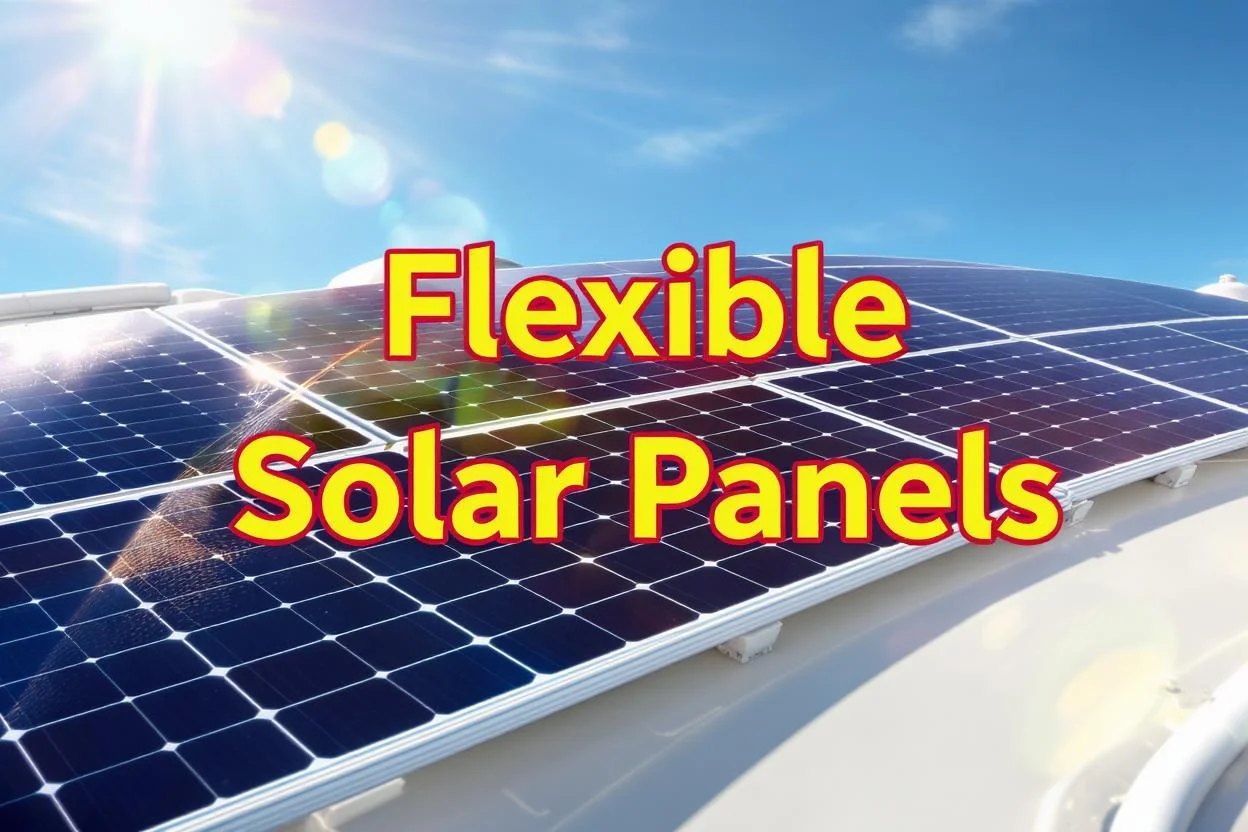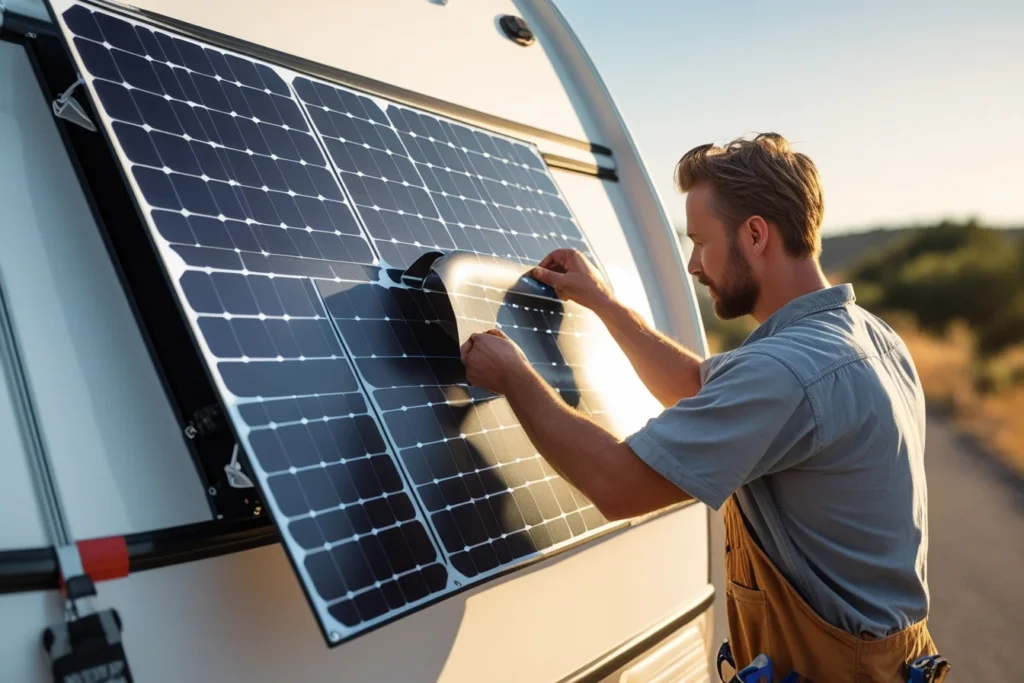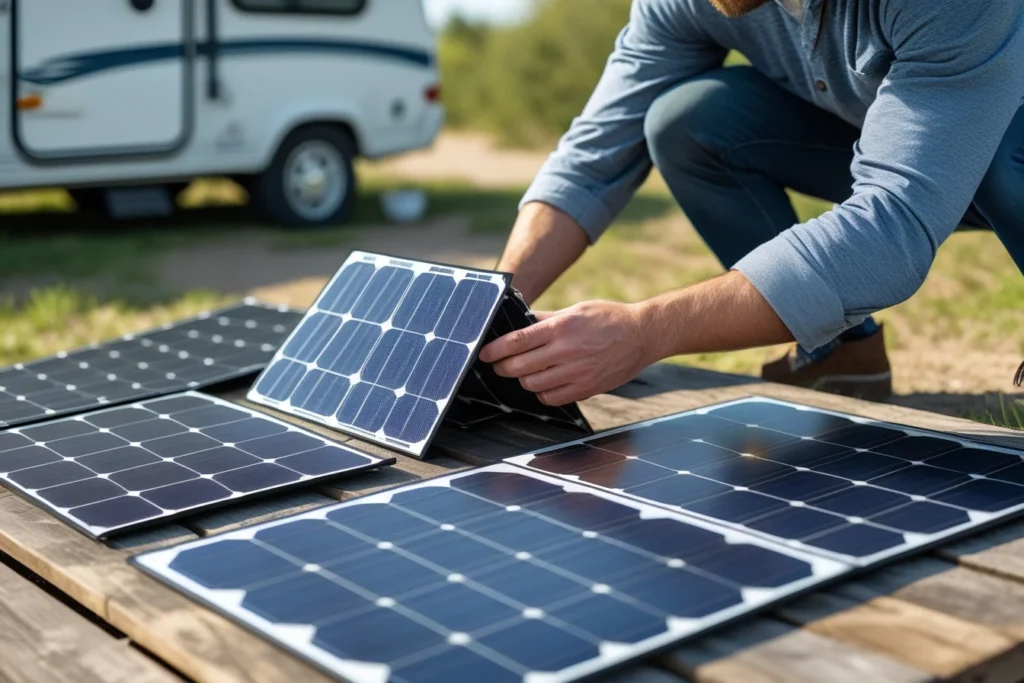Flexible Solar Panels Explained: Benefits, Costs, and Best Brands

Our use of clean energy is changing rapidly because flexible solar panels are lighter and more flexible than traditional rigid panels. These panels can easily meet your specific energy needs, whether you’re an off-grid adventurer, an RV traveler, or a homeowner seeking solar options that can be customized to fit your needs. Instead of being big and bulky, flexible solar panels can bend and fit on uneven surfaces, such as tents, roofs, boats, and backpacks, providing a wide range of placement options.
You will love how flexible solar panels make things easier and give you power. These solar panels are ideal for individuals seeking a portable, efficient, and durable way to harness solar power. They are suitable for individuals who live in campers, boats, or vans, as they are designed with cutting-edge solar technology and function effectively in low-light and adverse weather conditions. They are also easy to set up and require minimal maintenance, making solar energy more accessible than ever.
What Are Flexible Solar Panels?
Lightweight and thin solar panels, known as flexible solar panels, are made from materials such as amorphous silicon or CIGS (copper, indium, gallium, selenide). Unlike regular panels with glass, these are made to bend without breaking.
Key Features:
- Ultra-thin and lightweight
- Durable and weather-resistant
- Portable and easy to store
- Can bend up to 30 degrees or more
- Often have adhesive backing for quick installation
How Do Flexible Solar Panels Work?
Photovoltaic cells in flexible solar panels capture sunlight and convert it into power, just like those in rigid solar panels. The main change is in the structure and materials used.
Technology Behind It:
- Monocrystalline: Efficient but slightly less flexible
- CIGS: Offers better flexibility and durability
- Amorphous Silicon: Lower efficiency but excellent for partial shade
Top 10 Best Flexible Solar Panels (2025)
| Rank | Brand & Model | Wattage | Material | Efficiency | Flexibility | Best For | Price Range |
|---|---|---|---|---|---|---|---|
| 1 | Renogy 100W 12V Flex | 100W | Monocrystalline | 21% | Up to 248° curve | RVs, Vans, Marine | $170–$200 |
| 2 | SunPower 110W Flexible | 110W | Maxeon Cells | 23% | Up to 30° curve | Off-grid, high output | $250–$300 |
| 3 | ALLPOWERS 100W Flexible | 100W | Monocrystalline | 20% | Up to 30° curve | Camping, RVs | $140–$180 |
| 4 | Topsolar 100W Panel | 100W | Monocrystalline | 19% | Moderate bend | Budget setups | $100–$140 |
| 5 | XINPUGUANG 200W Kit | 200W (2x100W) | Monocrystalline | 20% | Semi-flexible | Boat/RV kits | $180–$220 |
| 6 | Rich Solar 100W Flex Panel | 100W | ETFE Coating | 20% | 30° bendable | Extreme environments | $160–$190 |
| 7 | HQST 100W Flexible Panel | 100W | Monocrystalline | 19.5% | 30° flex | Entry-level users | $110–$130 |
| 8 | BougeRV 100W ETFE Panel | 100W | ETFE Laminated | 20.5% | 30° flexible | Long-term outdoor use | $150–$180 |
| 9 | Winnewsun 100W CIGS Panel | 100W | CIGS Thin-Film | 17% | Ultra-flexible | Curved surfaces | $200–$230 |
| 10 | Eco-Worthy 120W Flexible | 120W | Monocrystalline | 19% | Moderate flex | Mid-range RV setups | $140–$170 |
Flexible Solar Panel Installation

It is much easier to install flexible solar cells than rigid ones. They’re very light and easy to bend, and they work great on RV roofs, boats, car tops, tents, and curved home surfaces. You can follow this guide whether you’ve done this before or this is your first time.
🛠 What You’ll Need
- Flexible solar panels (with pre-installed diodes or MC4 connectors)
- Charge controller
- Deep cycle battery (AGM, Gel, or Lithium)
- Inverter (if powering AC devices)
- Mounting adhesive or tape (VHB tape, Eternabond, or solar mounting glue)
- MC4 extension cables
- Wire cutters, crimper, multimeter
- Optional: drill & screws for semi-permanent setups
Installation Process
It’s easy to install flexible solar panels, which makes them great for do-it-yourselfers who want to power their RV, boat, or off-grid cabin. First, select a clean, dry, and debris-free mounting area. Features like the roof of an RV or the deck of a boat are ideal for flexible panels because they are typically smooth, curved, or flat. Isopropyl alcohol can be used to clean the area well.
Once the area is ready, put your flexible solar panel where it will get the most sunlight during the day. Mark its location with packing tape to make sure you put it in the right place. Use industrial-strength VHB tape with two sides or a flexible glue like Sikaflex or 3M 5200 to fix the panel. These make a strong link that won’t break in bad weather without drilling holes.
Hold the panel down firmly for about 30 seconds to ensure it sticks securely. Next, connect the MC4 connectors on the panel to the extension cords. Then, connect the cables to your solar charge controller. Ensure that the wires are kept away from any sharp edges and are out of harm’s way. Connect the charge controller to your battery, ensuring the positive cable is connected to the battery’s positive terminal and the negative cable is connected to the charge controller’s negative terminal.
If you have AC tools, connect the battery to an inverter. Finally, use a multimeter to check your system and make sure the panel is sending power and the battery is charging. Once you’re sure, your portable solar panel system is ready to provide clean, green power wherever you go.
Flexible Solar Panel Cost
| Wattage | Panel Type | Estimated Cost (USD) | Use Case |
|---|---|---|---|
| 50W | Budget/Entry-Level | $60 – $90 | Small electronics, backpacks |
| 100W | Standard Flexible Panel | $100 – $200 | RVs, vans, small setups |
| 110W | Premium High-Efficiency | $200 – $280 | Boats, off-grid high yield |
| 150W | Mid-Range Flexible Panel | $220 – $300 | Home backup, larger RVs |
| 200W | Dual Panel or High Power | $250 – $350 | Solar kits, full systems |
| 300W+ | Foldable/Flexible Kits | $350 – $500+ | Complete off-grid setups |
Benefits of Flexible Solar Panels
1. Portability
- Perfect for mobile applications like RVs, boats, and camping
- Roll or fold for easy transport
2. Easy Installation
- No heavy mounting systems
- Peel-and-stick or zip-tie methods
3. Versatility
- Can be mounted on curved surfaces
- Ideal for non-traditional settings
4. Lightweight Design
- No need for heavy support structures
- Reduces load on vehicles or roofs
Limitations to Consider
There are several advantages to bendable solar panels, including their lightweight design and ability to be used on curved surfaces. However, there are also some important things to keep in mind. One significant downside is that they are less efficient than regular fixed panels. This means that they may produce a little less power for the same surface area.
Additionally, flexible panels—especially those made of plastic—can deteriorate more quickly if exposed to prolonged UV light, particularly in harsh environments. They also need to be handled with more care because they don’t have a solid frame. If you bend them past their rated curve or step on them, you could damage the inside, which could lead to micro-cracks or poor performance over time.
Choosing the Best Flexible Solar Panels

When shopping for flexible solar panels, consider the following:
Wattage
- Higher wattage = more power output
- Common options: 50W, 100W, 200W
Durability
- Look for waterproof, UV-resistant panels
- Consider panels with ETFE coating for longevity
Installation Type
- Adhesive-backed vs. grommet holes
- Match the type to your application
Warranty and Support
- Reliable brands offer 1–5 year warranties
Top Brands Offering Flexible Solar Panels
| Brand Name | Panel Type |
|---|---|
| Renogy | ETFE Flexible Monocrystalline |
| SunPower | High-Efficiency Flexible Panels |
| Rich Solar | Lightweight Marine-Grade Panels |
| ALLPOWERS | Foldable Flexible Solar Panels |
| HQST | Bendable PET-Coated Panels |
| WindyNation | Off-Grid Flexible Solar Kits |
| Newpowa | Compact Flexible Solar Panels |
| PowerFilm Solar | Rollable Thin-Film Panels |
| Go Power! | RV & Mobile Solar Flexible Panels |
| BougeRV | Durable ETFE Flexible Panels |
Maintenance and Care Tips
The best way to make your foldable solar panels last longer and work more efficiently is to keep them in good condition. To clean the surface, use clean water and a soft cloth to gently wipe it down. Please refrain from using harsh chemicals or rough materials, as they can damage the panel coating. Always carefully roll or stack the panels when storing them to prevent bending or creasing, especially for thin-film models. Also, check your panels regularly for signs of wear, such as cracks, surface bubbles, or darkening, which could reduce their efficiency or indicate internal damage.
Solar panels can get dirty and dusty over time. Read our tips on how to clean solar panels to keep them working well.
Flexible Solar Panels vs. Rigid Solar Panels
| Feature | Flexible Panels | Rigid Panels |
|---|---|---|
| Flexibility | High | None |
| Installation | Easy, no drilling | Requires hardware |
| Durability | Moderate to high | Very high |
| Efficiency | Lower | Higher |
| Cost | Slightly higher/unit | More cost-effective |
FAQs about Flexible Solar Panels
Are flexible solar panels any good?
Yes, flexible solar panels are easy to move around, don’t weigh much, and work well on curved or portable surfaces, such as boats, RVs, and tents.
Are flexible solar panels as good as rigid?
Not quite. While flexible panels are easier to move around, they generally don’t work as well and don’t last as long as rigid panels.
Are flexible solar panels worth it?
They are well worth the money for mobile or off-grid setups that prioritize weight, space, and flexibility over efficiency.
Can you cut flexible solar panels?
No, cutting bendable solar panels can hurt the electronics inside and make the panels useless.
What is the life expectancy of flexible solar panels?
Flexible solar panels typically last between 5 and 10 years, depending on their quality and exposure to heat and sunlight.
Do you need an air gap for flexible solar panels?
Yes, it is recommended to allow some airflow under or around the panel to prevent it from overheating and losing its efficiency.
